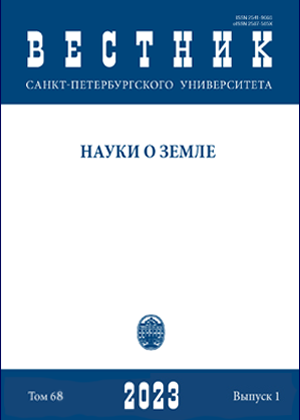Regional dimension of socio-cultural modernization of the population: results of expeditionary research in Uzbekistan and southern Kyrgyzstan
DOI:
https://doi.org/10.21638/spbu07.2023.104Abstract
The article attempts a regional measurement of the socio-cultural modernization of the population based on field observations and the results of in-depth interviews with the local population in Uzbekistan and southern Kyrgyzstan. Expedition research route: Osh — Kokand — Tashkent — Samarkand — Bukhara. For the regional measurement of population modernization, the following groups of indicators were used: “characteristics of the cultural landscape” (for example, the layout of settlements, home and space arrangement, land use, etc.) and “social portrait of local residents” (for example, clothing, food preferences, behavior in space, time budget and attitudes of the population). It was revealed that the most conservative and traditional population lives in the regions of the Fergana Valley, the less modernized — in Osh, Samarkand and Bukhara, the most modernized population — in Tashkent, Chirchik and Angren. It is found that regional differences in the socio-cultural modernization of the population correlate with the main provisions of the center-peripheral model. Deviations from it are determined by the nature of settlement, the ethnic structure of the population, the involvement of the population in labor migration, the measure of centrality and the absolute height of the settlement above sea level, etc. Thus, the intra-urban division of most cities into mahalla contributes to the preservation of the traditional community in the east and acts as a barrier to the socio-cultural modernization of the population. In the final part of the article, the national features of the socio-cultural modernization of the population of the studied countries are outlined (for example, the high stability of the national socio-cultural tradition, the multidirectional nature of modernization processes), and brief recommendations are given on the use of the research results in managing the socio-economic development of different regions.
Keywords:
modernization of society, innovation, socio-cultural tradition, lifestyle, gender issues, method of field observations, Kyrgyzstan, Uzbekistan
Downloads
References
Глейзер, О. Б. и Вайнберг, Э. И. (2013). Пространство жизнедеятельности населения как факторы и условия модернизации России. Регион: экономика и социология, 3 (79), 21-38.
Долгушин, М. И. (2008). Основные концепции модернизации. Вестник Вятского ГУ, 4, 57-63.
Зубаревич, Н. В. (2010). Регионы России: неравенство, кризис и модернизация. М.: Независимый ин-т социальной политики.
Комлев Н. Г. (2006). Словарь иностранных слов. М.: Эксмо.
Лапин, Н. И. (2011). Сверяем человеческие измерения модернизации (по результатам третьей волны Европейского социального исследования, 2006). Мир России. Социология. Этнология, 2, 33-73.
Линник, Е. В. (2005). Модернизация общества как фактор глобализации: Сравнительный анализ и типологизация. Дис.. канд. филос. наук.
Национальный атлас республики Узбекистан (2020). Ташкент: Картография.
Пантин, В. И. (1998). Циклы и волны модернизации как формы социальной эволюции. Дис.. д-ра филос. наук.
Побережников, В. И. (2001). Теории модернизации: основные этапы эволюции. Евразийское пограничье, 4, 217-246.
Стрелецкий, В. Н. (2018). Этнокультурный плюрализм Северного Кавказа в контексте «вызовов» и трендов модернизации традиционного общества (социо- и культурно-географические аспекты). В: Поляризация российского пространства: экономико-, социально- и культурно-географические аспекты. М.: ИП Матушкина И. И., 87-101.
Трейвиш, А. И. (2017). Географические факторы модернизации общества: некоторые уроки Всемирной и Российской истории XIX-XX веков. Вестник Московского университета. Серия 5. География, 6, 3-8.
Abumere, S. I. (1981). The geography of modernisation: some unresolved issues. GeoJournal, 5, 67-76. https://doi.org/10.1007/BF00185245
Agadjanian, V., Nedoluzhko, L., Kumskov, G. (2008). Eager to leave? Intentions to migrate abroad among young people in Kyrgyzstan.International Migration Review, 42 (3), 620-651. https://doi.org/10.1111/j.1747-7379.2008.00140.x
Banks, A. S. and Carr, D. L. (1974). Urbanization and modernization: A longitudinal analysis. St Comp Int Dev, 9, 26-45. https://doi.org/10.1007/BF02800437
Billig, M. (2016). Effects of the forced resettlement of a community from an agricultural settlement to a high-rise building. GeoJournal, 81, 123-137. https://doi.org/10.1007/s10708-014-9604-4
Inglehart, R. (2020). Modernization and postmodernization: Cultural, economic, and political change in 43 societies. Princeton University Press. https://doi.org/10.2307/591300
Jones, A. H. (1971). The spatial dimension of modernization in Uganda: basic aspects and implications. The East African Geographical Review, April, 79-86.
Lu, Q., Zhan, Jy., Lee, Kw. (2001). An overview on the urban-rural interaction in the past 50 years in China. Chin. Geograph. Sc., 11, 193-200. https://doi.org/10.1007/s11769-001-0015-3
Lundqvist, J. (1974). Structure and process of modernization. Some remarks on recurrent features in geographical studies of modernization. Norsk Geografisk Tidsskrift-norwegian Journal of Geography, 28, 103-113.
Shi, J. (2017). The evolvement of family intergenerational relationship in transition: mechanism, logic, and tension. The Journal of Chinese Sociology, 4, 1-20. https://doi.org/10.1186/s40711-017-0068-z
Soja, E. W. (1989). Postmodern Geographies: The Reassertion of Space in Critical Social Theory. London: Verso Press.
Stevens, S. F. (1991). Sherpas, Tourism, and Cultural Change in Nepal’s Mount Everest Region. Journal of Cultural Geography, 12, 32-58.
Downloads
Published
How to Cite
Issue
Section
License
Articles of "Vestnik of Saint Petersburg University. Earth Sciences" are open access distributed under the terms of the License Agreement with Saint Petersburg State University, which permits to the authors unrestricted distribution and self-archiving free of charge.






